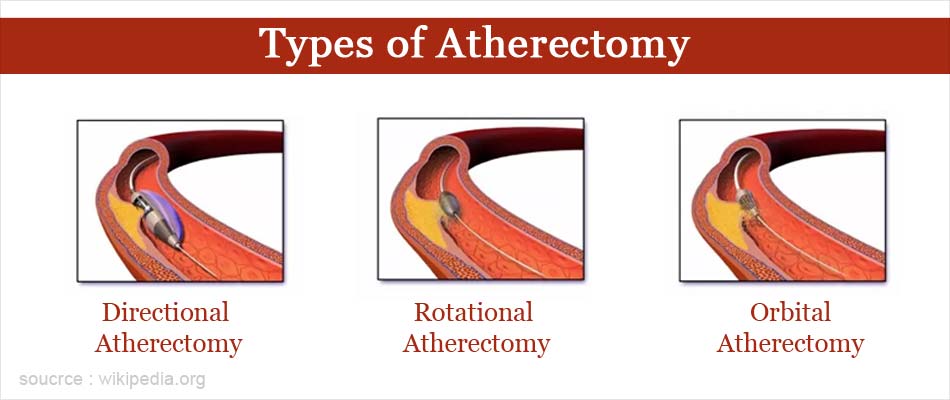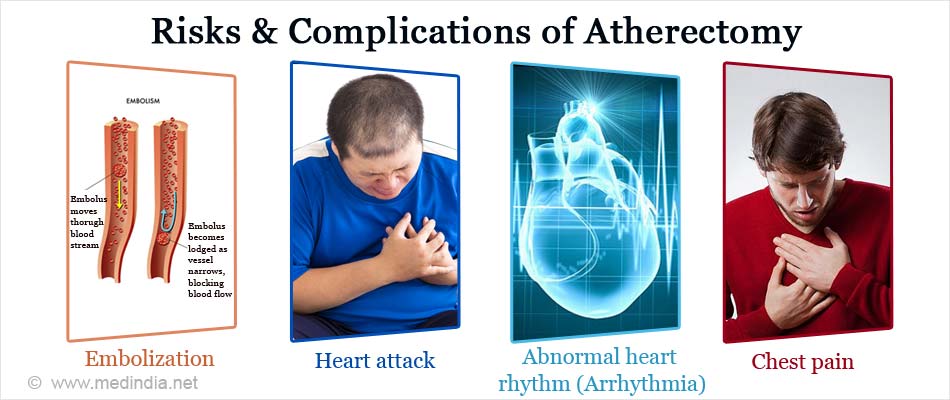What is Atherectomy?
Atherectomy simply means excision or removal of an atheroma.
An atheroma is an abnormal accumulation of fat with an overlying fibrous cap within the wall of a blood vessel. As the accumulation enlarges in size, the vessel progressively narrows, affecting blood flow to the organ or tissue it supplies. This resultant condition, called atherosclerosis, can be life-threatening if important blood vessels like the coronary arteries (the blood vessels supplying the heart), are affected.
During an atherectomy procedure, the accumulated plaque is removed gently using a specially tipped instrument attached to a catheter. The catheter is introduced into a peripheral artery such as the femoral artery and advanced into the affected vessel.
Why is Atherectomy Done?
Atherectomy is done for the following indications:
- To restore blood flow to the affected tissue or organ in patients whose coronary or peripheral blood vessels have been affected by atherosclerosis.
- In patients who need a coronary angioplasty but the plaque is too hard and calcified. In such cases, an atherectomy is performed to break the atheromatous plaque, and may be followed by angioplasty and/or stent placement if necessary.
- Occasionally, to remove build-up of plaque that may occur after an angioplasty.
What are the Types of Atherectomy?
There are four types of atherectomy depending on the type of device that is attached to the catheter for removing the plaque. These include:
- Directional atherectomy – The catheter is provided with a cutting tip that shaves the plaque off gently. The pieces are collected in a separate part of the catheter and removed. The devices for directional atherectomy approved by the US FDA can be used only for peripheral blood vessels and not for the coronary, carotid, iliac, or renal arteries.
- Rotational atherectomy – The cutting tip spins at high speed and grinds the plaque into a powder that is then washed away safely in the bloodstream.
- Laser atherectomy – The catheter tip is provided with a device that emits high-energy laser to alter or vaporize the plaque material.
- Orbital atherectomy – This is the latest technique that uses a high-speed rotational device similar to the rotational atherectomy but with a slightly modified tip.

The type of device to be employed is decided by the doctor based on the type of lesion being treated and his expertise with a specific type.
How Do You Prepare Before an Atherectomy?
- If a coronary artery disease (CAD) is suspected, a coronary angiogram is first performed, by injecting a contrast dye into the arterial system and the coronary vessels are then visualized on x-ray to determine the location and extent of blockages of the blood vessels and decide upon mode of treatment.
- Once the decision to perform an atherectomy is made, then as for any surgical procedure, several blood tests, urine tests and imaging tests will be carried out to assess your general health condition.
- You will be advised to quit smoking, or at least stop smoking for a few weeks before and after the procedure. Inform your doctor if you are allergic to any medications or contrast dyes, to prevent a reaction during the procedure.
- Any abnormal test results such as underlying infection, uncontrolled blood sugar or low hemoglobin concentration (anemia) may have to be corrected with treatment before the atherectomy procedure.
- Additional tests such as electrocardiogram (ECG), echocardiogram and chest x-ray are done to assess the heart and lung condition before surgery.
- You will be advised to admit yourself to the hospital on the evening prior to the procedure.
- You should not eat anything for at least 10 hours prior to the procedure.
- You may be given a sedative the night before to keep you calm
- The skin over the operative site will be cleaned and prepared by shaving off hair that may be present.
- You can have a bath as usual and will then be given a surgical gown to wear before being wheeled into the operation theatre.
What Happens During the Atherectomy Procedure?
- Once the patient is taken to the operating theatre, he is shifted on to the operating table.
- The procedure is usually done under local anesthesia and a mild sedative is administered intravenously.
- Medications to control the blood pressure, to relax blood vessels and to prevent clot formation are administered during the surgery.
- A thin flexible tube (catheter) is inserted into the femoral artery in the thigh via a small incision and guided up into the narrowed blood vessel using imaging guidance.
- Using the guide wire, a catheter with a sharp cutting/rotating tip is guided across the block and maneuvered such that the plaque is exposed to the cutter.
- The tip is activated and the plaque is removed. The catheter may have to be passed several times to remove large amounts of plaque.
- Removal of plaque may be followed by balloon angioplasty and stent insertion.
- A dye contrast is then injected to check if the arteries are patent and blood flow to the organ is restored.
- After ensuring that everything is okay, the catheter is removed and the skin wound covered with a dressing.
- The procedure typically takes around a couple of hours.
What Happens After Atherectomy?
- Immediately after the procedure, pressure is applied over the dressing for at least 20 minutes.
- The patient is shifted to the coronary care unit if the procedure is done on the coronary arteries where he will remain for a few hours. Here, initially, the patient’s blood pressure and ECG are monitored every 15 minutes.
- Painkillers are administered intravenously.
- The patient has to lie flat on his back and avoid bending the knees for around 6 hours after the procedure.
- He is advised to press the operative site with his fingers if he needs to cough or sneeze.
- A minimum of 1-2 days stay in the hospital may be necessary until the patient is stabilized.
- Lifting of heavy weights and strenuous exercise should be avoided for at least 2-3 weeks following the procedure.
- Normal diet and drugs taken previously can be resumed as per the doctor’s advice.
- A follow up visit to review the patient’s condition is usually arranged in a week or ten days after discharge.
What are the Risks and Complications of Atherectomy?
Atherectomy is a safe procedure and the risks are similar as for balloon angioplasty. They include:
- Bleeding around the heart
- Injury and tearing of the blood vessel wall
- Embolization, in which the dislodged clot can travel along the blood vessel and block another blood vessel
- Chest pain
- Heart attack
- Disturbances in heart rhythm (arrhythmias)
- A complete block to a blood vessel requiring emergency bypass
- Allergic reaction to the contrast dye or local anesthetic used during the procedure

Health Tips
- Have a healthy balanced diet. Avoid foods that are rich in fat.
- Reduce or quit smoking altogether.
- Be active and exercise/walk for at least 20 minutes every day.
- Practice stress relief techniques such as yoga or meditation.
- Get at least 8 hours of sleep each night.
- Spend time with friends and family.
- Pursue a hobby or activity that you find enjoyable to relieve stress






